Snapshots of a Free State
Published in 20th Century Social Perspectives, 20th-century / Contemporary History, Features, Issue 1 (January/February 2019), Volume 27Norwegian Ole Mørk Sandvik’s 1927 visit to Ireland.
By David Toms
Ole Mørk Sandvik was unimpressed by Dublin on his arrival in Ireland’s capital in the summer of 1927, describing it as an ‘English city’, and boring for all that. He was equally nonplussed by Cork, which he felt shared much of the same character as Dublin—that is, these were not truly ‘Irish’ places. Sandvik had come to Ireland in the hopes of finding—as had others before him and as would others after him—something untouched in Irish culture, something in the people and the places that was old, a sound, a song that he could trace back in time to the days of Viking raids. Sandvik was around 50 when he undertook this journey, for which he had backing from Norway’s Research Council and which was organised at the Irish end by some people with whom he had corresponded. His hair was greying, and he was tall and thin. He was unmistakably Norwegian. He would make his way from Dublin to Cork and then onward to Ballingeary and Cill Rialaig, before returning to Dublin and heading back to Norway via the Hebrides. It would take him all of July and August to complete the trip.
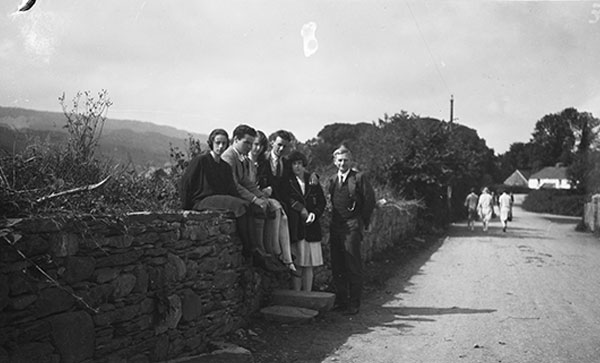
Above: Øle Mørk Sandvik (standing, right) with other students from Coláiste na Mumhan in Ballingewmary, Co. Cork, where he learned Irish. (Nasjonalbiblioteket, Norway)
Background
Who was Sandvik and what was he seeking when he arrived in Ireland with introductions that would take him to the hearths and homes of the people of West Cork and Kerry? He was born in May 1875 on Helgøya, a small island in Ringsaker near Hamar, far inland in eastern Norway. He would live to the age of 101, dying in August 1976. In that century-long lifetime, Sandvik would cement his place as one of Norway’s greatest scholars: he was by turns a teacher, music researcher and folk-song collector. His body of published work in Norwegian is enormous, taking in folk-songs and religious hymns.
His trip to Ireland in the summer of 1927 was long in the making and was to have a profound impact on him. One of the most striking aspects of the trip were the photographs that he took. There are over 100 of them, many taken by Sandvik or by the friends he made along the way. The images offer a unique perspective on the world of Ballingeary and Cill Rialaig in the infancy of the new Irish Free State. We get, moreover, a better sense of how an outsider with intimate access saw—literally and figuratively—the people he wished to interview and record.
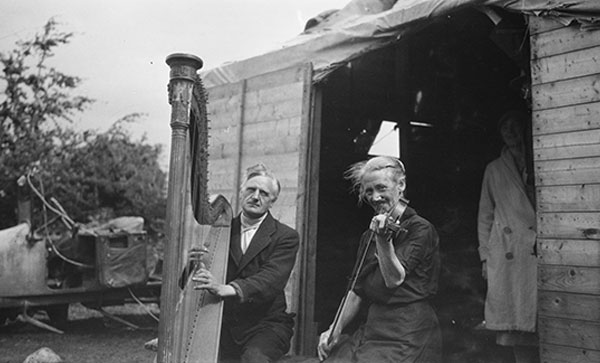
Above: Two musicians playing at an open-air feis in Ballingeary, which captures perfectly the ephemeral aspect of what Sandvik’s trip was trying to achieve—to catch a tradition as practised, in the moment of performance. (Nasjonalbiblioteket, Norway)
Romantic generalisations
Ethnomusicology, a young discipline in Sandvik’s time, was a practice still heavily influenced by the idea that modernity had somehow sullied a purer state of being for the rural people of the world, whose songs and stories came from a time immemorial. Sandvik was in part guilty of this attitude in his refusal to see either Dublin or Cork as truly Irish. He was to write in notes for a lecture that the language of Irish is ‘a richer path to enduring independence [that] cannot be imagined … It seems as if English, artistically speaking, is an altogether impossible medium for the lively, imaginative Irish who think in pictures.’
He wrote of a people ‘gifted with fantasy, singers, musicians, handsome Nordic types—on the whole anyhow—people one immediately has sympathy for, the best of them inspired by patriotic determination in an apparently hopeless battle’, a romantic generalisation that was itself a flight of fancy. Such a view was in keeping with the kind of things that another great folk-song collector, Cecil Sharp, would write of the people of the Appalachians. Sharp, when seeking the permutations of English folk-song in America a decade before Sandvik’s trip, wrote:
‘In their general characteristics they remind me of the English peasant … there are differences, however. The mountaineer is freer in his manner, more alert, and less inarticulate than his British prototype.’
Simple in their directness, naive in their openness—such characteristics are apparently shared by the peasantry and holders of tradition the world over, if Sandvik and Sharp are to be believed.
Learned Irish
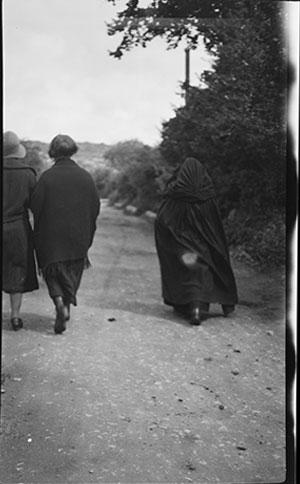
Above: Women walking down a road in Ballingeary, one wearing a traditional shawl. (Nasjonalbiblioteket, Norway)
For Sandvik, the only real tradition-bearers of note in Ireland were Irish-speakers. As a Norwegian born during the union with Sweden and a young man in 1905 when the union was dissolved and Norway became fully independent, language and nation were synonymous to him. So seriously did Sandvik take this, and to help navigate his way around West Cork and Kerry, that he spent part of his time in Ireland attending Coláiste na Mumhan, a summer school to help improve the Irish of new National School teachers. It was here that Sandvik would mix with serious language enthusiasts like Liam de Róiste.
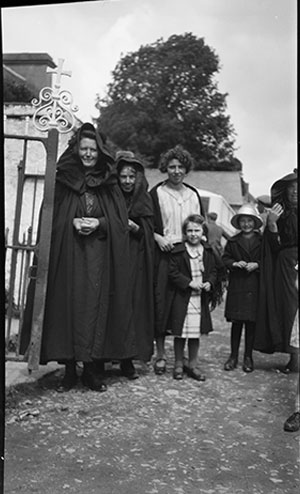
Above: Women and children stand at Ballingeary church gate. Again, note the hooded shawls, which must have struck Sandvik as distinctively Irish. (Nasjonalbiblioteket, Norway)
His willingness to learn Irish, and his desire to seek out music from the remotest parts of Ireland, was driven by a belief that there must be some link between the folk-musics of Norway and Ireland. Before going, he wished to see what (if any) impact the Vikings had had on Irish folk-music, although by the end of his trip he would take the view that the influence had been the other way round. Returning Vikings would bring back what Sandvik called the ‘melisma’ of Irish folk-singing, which would root itself in the work-songs of Norwegian farmers. The ornamentation that marked out Irish singing as unique to Sandvik’s ear, especially in the art of keening—singing and wailing over the dead—was to be found (according to Sandvik) in the cattle calls of farmers in eastern Norway, where he had spent his childhood.
Photographs
Sandvik’s photographs were for personal use only; there is no sense from the diaries of the trip that Sandvik saw them as supplements to his research. Sandvik did not, for instance, reproduce the photo of the musicians in the article he published on the trip. Nor did he include the cost of the camera and other photographic equipment in his report to the Norwegian Research Council. The photographs, then, are a personal record of a research field trip. This is further borne out by a postcard in his papers from Fionan MacColum:
‘A doitín, Sandvik, a chara … the photographs turned out well. I gave the cailin, Mairin Ni Shuilleabháin, who sang to make records for you, the two for herself and her chum. I haven’t seen Bradley or Galvin. The one with Galvin and myself down at Foley’s is nice too and if you are printing photos a few more copies of that might not be too much trouble to send.’
The photographs offer a window into the places Sandvik saw, the places and people he thought worth recording in this most permanent of ways. They give us a sense of the eye of Sandvik himself as he made his way around Ballingeary and Cill Rialaig. We know from a small handful of other photographs held in Norway’s National Library that Sandvik took photos on other research trips and that he was interested in similar motifs at home too. Rural Ireland and its people are the subject-matter worthy of note.
The photographs teem with life. The range of subjects is equally interesting. Some photographs show people in their homes and in the fields, great groups of sisters in a convent, people standing proudly next to motor cars, students relaxing after Irish classes (including Sandvik himself). Photos of the village of Cill Rialaig show the poverty of the people in stark terms. There are portraits and action shots. There are also landscapes—photographs of ruined castles and abbeys, and of the open countryside.
Often taken on the hoof, some of these snapshots have turned out poorly, badly focused or with low exposure to the light, while others have an artful quality that suggest that Sandvik was a good amateur photographer. As we do not know the exact model of camera he used, we can only surmise that it was either a fold-up or box camera, with a likely shutter speed of around 1/250. From the number of cut legs in the photos, and from one photo in which we see Sandvik’s shadow on the ground, his camera’s viewfinder was probably on top, meaning that the photos are more often than not taken from around waist height.
Audio recordings
Sandvik recorded a great many samples of speech and song on his trip, and noted down melodies. Many of the recordings still survive, as do the notes of a lecture that he gave, in English, at UCD that summer. Here he would tell his audience: ‘I have been in many countries and heard folk music, but never I heard tunes alike yours’. Sandvik was clearly impressed and moved by much of what he saw and heard on his journey.
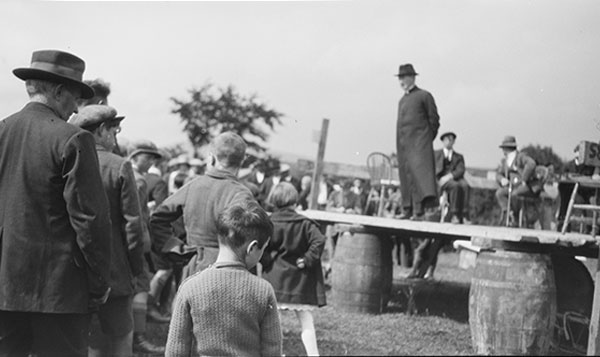
Above: Fr O’Nolan, in whose house Sandvik was a guest, gives a speech to the attendees at the feis in Ballingeary. (Nasjonalbiblioteket, Norway)
Sandvik intended to return to Ireland to continue his research but never did; he failed to secure further funding for this work. His 1927 trip was his one and only close encounter with Ireland but it left a lasting impression. The article he would write based on his research was published much later as ‘Keltiske Melodier og Norsk Folkemusikk’ [Celtic melodies and Norwegian folk-music] in Norsk Musikkgranskning Årbok in 1940. It is here that he would write that ‘that irreplaceable something, the intensively Norwegian within our folk tunes … is to be sought in the far west, in those cultures which once enticed our forefathers to embark upon their Viking expeditions’.
Conclusion
Sandvik, after his time in Ireland, would travel on to the Hebrides to conduct similar research before returning home at the end of the summer. His camera would capture the people of the Hebrides in much the same way as it did the people of Ballingeary and Cill Rialaig. The photographs he took almost a century ago entice us too. They give us an outsider’s view of an Ireland in flux—a country caught between the bright future of recently won statehood and a deep desire to retain those aspects of traditional culture that could form the basis of a unique Irish identity through language, song and music. Sandvik was alive to these tensions during his trip. The photographs show us an Ireland that is indeed vanished, as any past vanishes. Yet many of the photographs have an immediacy, a naive compositional skill that is full of life, full of the verve of a young country embarking on a new path while attempting to remain loyal to its traditions. It shows a people keen to share those same traditions not only among its own population but also with those, like Sandvik, who would make the journey to engage with them.
David Toms is the author of Soccer in Munster: a social history, 1877–1937 (Cork University Press, 2015); he currently lives and works as an independent researcher in Oslo, Norway.
FURTHER READING
P. Burke, Eyewitnessing: the uses of images as historical evidence (Ithaca NY, 2006).
O. Campbell & C.J. Sharp, English folk songs from the Southern Appalachians (Whitefish MA, 1917).
S. Ó Catháin, Gaelic grace notes: the musical expedition of Ole Mørk Sandvik to Ireland and Scotland (Dublin, 2014).
















